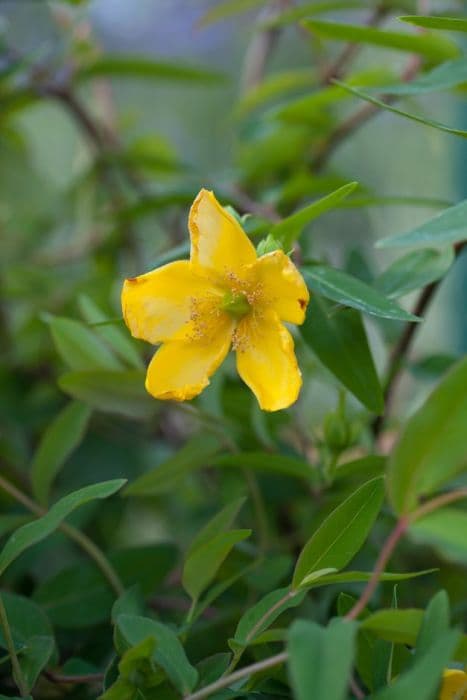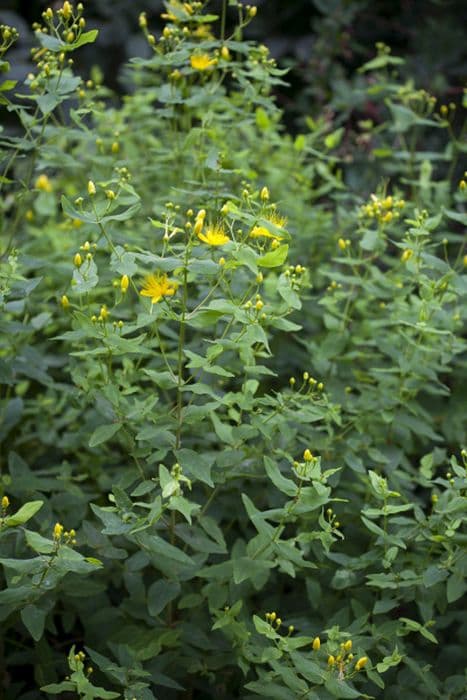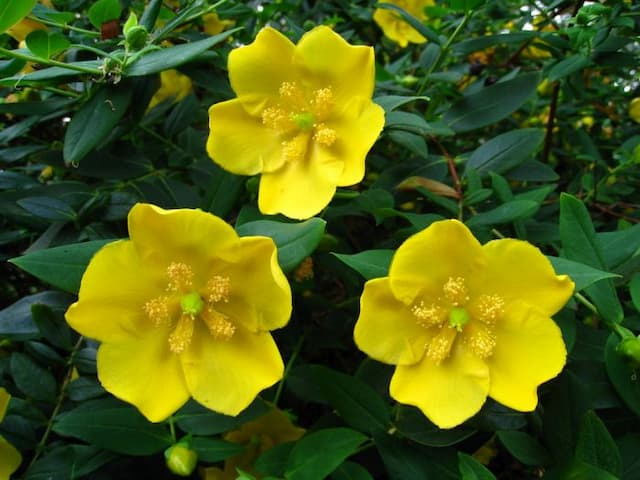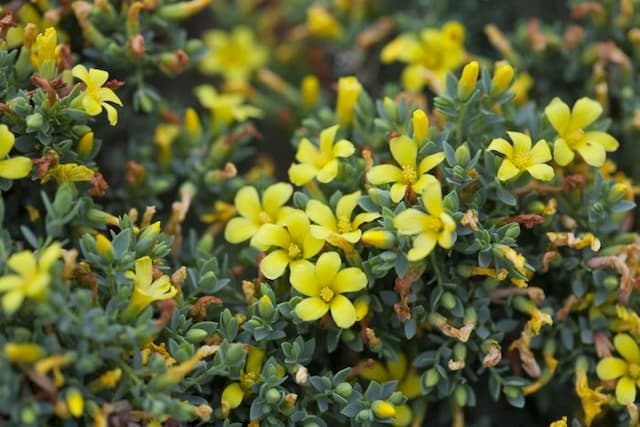St John's Wort Hypericum × moserianum
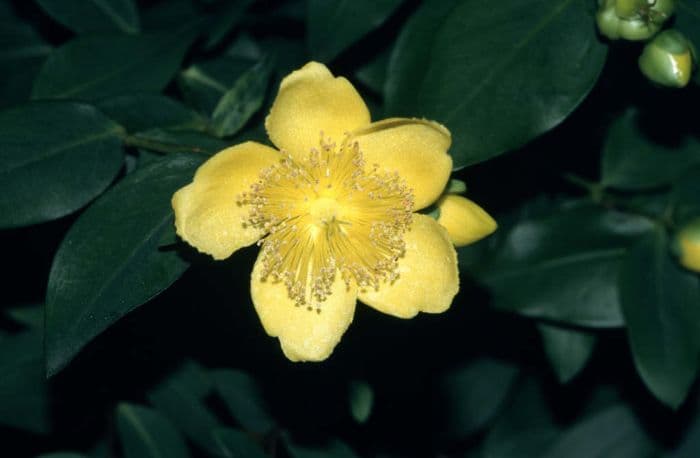
ABOUT
The plant in question, commonly known as St. John's Wort, is a decorative and visually appealing perennial with a bushy, spreading habit. It is renowned for its vibrant flowers and lush foliage. The leaves are typically a rich, deep green color, with a slightly glossy texture and oval to oblong shape, often appearing in opposite pairs along the stems. The flowers of St. John's Wort are particularly striking, with a distinctive bright yellow hue that adds a splash of color to gardens when in bloom. The blossoms are characterized by a profusion of stamens, which are prominent and create a fluffy appearance, contrasting beautifully with the yellow petals. These flowers are generally small to moderate in size and have a star-like shape, usually with five petals. St. John's Wort is often used in landscaping as a ground cover or in borders, due to its attractive, dense foliage and the cheerful yellow flowers that can catch the eye and brighten up outdoor spaces. The overall appearance of this plant is one of versatility and beauty, making it a favorite among gardeners seeking to add long-lasting color to their plantings.
About this plant
 Names
NamesFamily
Hypericaceae
Synonyms
St. John's Wort, Moser's St. John's Wort, Goldflower, Tricolor St. John's Wort
Common names
Hypericum × moserianum
 Toxicity
ToxicityTo humans
St. John's Wort, the common name for Hypericum × moserianum, is not highly toxic to humans. Ingesting parts of this plant typically does not lead to serious poisoning. However, it can cause some gastrointestinal symptoms, such as nausea, vomiting, and diarrhea, if consumed in significant quantities. More important is its potential interaction with various medications if ingested, as it can affect the metabolism of certain drugs.
To pets
St. John's Wort is considered to be mildly toxic to pets, including dogs and cats. If a pet ingests parts of this plant, they may experience symptoms such as gastrointestinal upset, which could include vomiting and diarrhea. In some cases, there might be photosensitization, where the pet's skin becomes more sensitive to sunlight, leading to dermatitis or other skin conditions, but this is more commonly associated with larger quantities of ingestion. If you suspect your pet has ingested St. John's Wort, it's best to consult a veterinarian.
 Characteristics
CharacteristicsLife cycle
Perennials
Foliage type
Semi-deciduous
Color of leaves
Green
Flower color
Yellow
Height
1-2 feet (30-60 cm)
Spread
1-2 feet (30-60 cm)
Plant type
Shrub
Hardiness zones
5
Native area
Cultivar
Benefits
 General Benefits
General Benefits- Ornamental Appeal: The plant, commonly known as St. John's Wort, has bright yellow flowers that enhance the visual appeal of gardens and landscapes.
- Attracts Pollinators: Its flowers attract bees and other pollinators, supporting local ecosystems.
- Ease of Care: Hypericum × moserianum is known for being low-maintenance and can thrive with minimal care.
- Drought Tolerance: It is relatively tolerant to dry periods, making it suitable for a variety of climates.
- Deer Resistance: St. John's Wort is generally resistant to deer, which makes it a good choice for gardens in areas where deer are prevalent.
 Medical Properties
Medical PropertiesThis plant is not used for medical purposes.
 Air-purifying Qualities
Air-purifying QualitiesThis plant is not specifically known for air purifying qualities.
 Other Uses
Other Uses- St. John's Wort oil infusion can be used in woodworking to add a rich, deep finish to wood while subtly enhancing the natural grain.
- Dried St. John's Wort stems and flowers are utilized in crafting potpourri for a light, aromatic appeal in home decor.
- The plant's flowers provide a natural dye for textiles, producing a range of colors from yellow to deep red, depending on the mordant used.
- St. John's Wort is an ingredient in some natural insect repellents, with its aroma believed to ward off certain pests.
- Due to its dense and bushy nature, it’s used for creating low, informal hedging in landscape design.
- The vibrant flowers can be pressed and used in botanical art or bookmark crafting for a touch of natural beauty.
- It is used in floral arrangements, particularly in dried flower displays, where its bright yellow blooms add a splash of color.
- St. John's Wort can feature in natural, eco-friendly burial practices, with the plant incorporated into biodegradable funeral wreaths.
- In fish-keeping, dried leaves of the plant are sometimes added to aquariums for their potential anti-bacterial properties.
- The plant can serve as a natural indicator of soil health, with robust growth suggesting good soil conditions and fertility.
Interesting Facts
 Feng Shui
Feng ShuiThe St. John's Wort is not used in Feng Shui practice.
 Zodiac Sign Compitability
Zodiac Sign CompitabilityThe St. John's Wort is not used in astrology practice.
 Plant Symbolism
Plant Symbolism- Protection: Hypericum, commonly known as St. John's Wort, is traditionally associated with warding off evil spirits and negative energies, which is why it was often hung over religious icons or images in the home.
- Healing: Due to its medicinal properties, particularly in treating depression and wounds, St. John's Wort embodies healing both of the mind and body.
- Strength: This plant's hardiness and ability to thrive in challenging environments symbolize inner strength and the ability to overcome obstacles.
- Good Fortune: St. John's Wort is believed to bring good luck and is sometimes used in rituals or carried as a charm for this purpose.
 Water
WaterThe St. John's Wort should be watered regularly, aiming to keep the soil consistently moist but not soggy. During the growing season, water the plant thoroughly once a week, using approximately one gallon of water for an outdoor shrub of average size. Watering frequency should be reduced during the winter to every two weeks or less, depending on the climate and indoor heating conditions. Always check the top inch of soil for dryness before watering again. Overwatering can lead to root rot, so it's crucial to provide good drainage.
 Light
LightSt. John's Wort thrives in full sun to partial shade. It is adaptable but will flower best when it receives at least six hours of direct sunlight daily. If you're growing it indoors, place it near a south-facing window where it can receive ample light. Avoid deep shade as this can reduce the plant's flowering potential and lead to leggy growth.
 Temperature
TemperatureSt. John's Wort prefers a temperate range of temperatures and can tolerate a variety from approximately 50°F to 85°F. It can survive minimum temperatures down to 0°F once established, but young plants should be protected from severe cold. Ideal conditions are consistent, moderate temperatures without the extremes of frost or intense heat.
 Pruning
PruningPrune St. John's Wort in early spring to remove any dead or damaged growth and encourage bushy new foliage. It can also be pruned after flowering to shape the plant and promote more blooms the following season. Pruning is typically done annually, but lightly trimming throughout the season can maintain the desired shape and size.
 Cleaning
CleaningAs needed
 Soil
SoilSt. John's Wort thrives best in well-drained soil with a pH range of 5.5 to 7.0, a mix comprising of loam, sand, and leaf mold or peat moss is ideal.
 Repotting
RepottingSt. John's Wort should be repotted every 2-3 years to replenish nutrients and to prevent it from becoming root-bound.
 Humidity & Misting
Humidity & MistingSt. John's Wort prefers moderate humidity levels but is quite adaptable and can tolerate the drier air found in most homes.
 Suitable locations
Suitable locationsIndoor
Place St. John's Wort in bright, indirect light and avoid overwatering.
Outdoor
Plant in full sun to partial shade and ensure soil drainage.
Hardiness zone
5-9 USDA
 Life cycle
Life cycleHypericum × moserianum, commonly known as St. John's Wort, begins its life cycle when seeds germinate in late winter or early spring, requiring light to initiate the process. After germination, seedlings grow into young plants, putting out a basal rosette of leaves; as warmer weather arrives, these develop into bushy, erect stems. The plant's growth stage continues throughout the spring and early summer, as it develops numerous yellow flowers characterized by their prominent stamens. After the flowering period in mid to late summer, pollinated flowers set seed that will eventually dry and disperse in late summer to autumn, completing the reproductive cycle. During the fall, Hypericum × moserianum enters a period of dormancy, with the above-ground portion dying back with the onset of cold weather while the root system remains alive to regenerate the next spring. Deciduous in colder climates, the plant may retain some foliage in milder winters.
 Propogation
PropogationPropogation time
Summer
The most popular method of propagating Hypericum × moserianum, commonly known as St. John's Wort, is by semi-ripe cuttings. This is typically done in late summer. To propagate, one should select healthy, semi-ripe stems and cut segments approximately 4 to 6 inches (about 10 to 15 cm) long. Each cutting should have several leaves and be cut just below a leaf node. The lower leaves are then stripped, and the base of the cutting is dipped in a rooting hormone to enhance root development. The prepared cuttings are inserted into a pot filled with a well-draining potting mix or a mixture of peat and sand. The pot should then be placed in a warm, bright area but not in direct sunlight and kept moist until roots develop, which usually takes several weeks.
